The Nucleation and Degradation of Pothole Wetlands by Human-Driven Activities and Climate During the Quaternary in a Semi-Arid Region (Southern Iberian Peninsula)
Abstract
1. Introduction
2. Regional Framework
3. Methodology
3.1. Data Sources
3.2. Hydrological Analysis
3.3. Structural Analysis
3.4. Land Use
4. Results
4.1. Climatic Parameters
4.2. Post-Pliocene Structures
4.3. Flood-Prone Areas Characterization
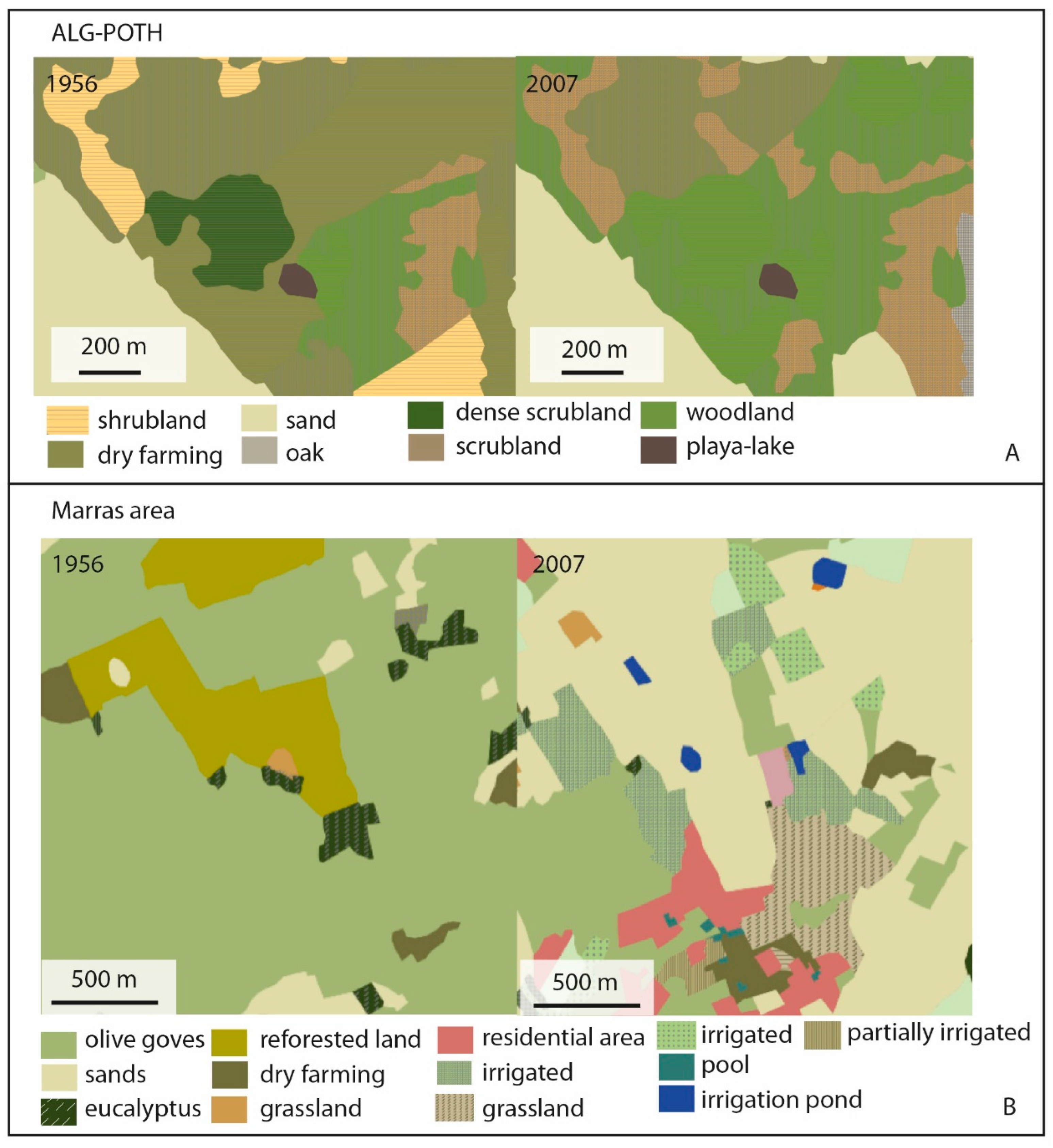

5. Discussion
5.1. Alcores Depression Inception
5.2. Pothole Wetlands’ Hydrological Functioning and Degradation
5.3. Comparisons with Other Pothole Wetlands and Managerial Implications
6. Conclusions
Author Contributions
Funding
Data Availability Statement
Conflicts of Interest
References
- Bennett, K.D.; Tzedakis, P.C.; Willis, K.J. Quaternary Refugia of North European Trees. J. Biogeogr. 1991, 18, 103–115. [Google Scholar] [CrossRef]
- Barker, G. The Agricultural Revolution in Prehistory: Why Did Foragers Become Farmers? Oxford University Press: Oxford, UK, 2006. [Google Scholar]
- Di Angelo, L.; Di Stefano, P.; Guardiani, E.; Morabito, A.E.; Pane, C. 3D Virtual Reconstruction of the Ancient Roman Incile of the Fucino Lake. Sensors 2019, 19, 3505. [Google Scholar] [CrossRef] [PubMed]
- Erdoğan, S. Archaeological sites and historic buildings in Turkish wetlands. In Culture and Wetlands in the Mediterranean: An Evolving Story; Med-INA: Athens, Greece, 2011. [Google Scholar]
- Zittis, G.; Almazroui, M.; Alpert, P.; Ciais, P.; Cramer, W.; Dahdal, Y.; Fnais, M.; Francis, D.; Hadjinicolaou, P.; Howari, F.; et al. Climate Change and Weather Extremes in the Eastern Mediterranean and Middle East. Rev. Geophys. 2022, 60, e2021RG000762. [Google Scholar] [CrossRef]
- Guardiola-Albert, C.; Jackson, C.R. Potential Impacts of Climate Change on Groundwater Supplies to the Doñana Wetland, Spain. Wetlands 2011, 31, 907–920. [Google Scholar] [CrossRef]
- Kalettka, T.; Rudat, C.; Quast, J. Potholes in Northeast German agro-landscapes: Functions, land use impacts, and protection strategies. In Ecosystem Approaches to Landscape Management in Central Europe, Ecological Studies; Springer: Berlin/Heidelberg, Germany, 2001; pp. 291–298. [Google Scholar]
- González-Sampériz, P.; Valero-Garcés, B.; Moreno, A.; Jalut, G.; García-Ruiz, J.; Martí-Bono, C.; Delgado-Huertas, A.; Navas, A.; Otto, T.; Dedoubat, J. Climate variability in the Spanish Pyrenees during the last 30,000 yr revealed by the El Portalet sequence. Quat. Res. 2006, 66, 38–52. [Google Scholar] [CrossRef]
- Carrión, J.S.; Ochando, J.; Michelangeli, F.; Jiménez-Espejo, F.; Ojeda, F.; Amorós, G.; Munuera, M.; Marín-Arroyo, A.B.; González-Sampériz, P.; Rodríguez-Vidal, J.; et al. Tracing 40,000 years of vegetation change in the Baetic-Rifan biodiversity hotspot. Rev. Palaeobot. Palynol. 2024, 331, 105202. [Google Scholar] [CrossRef]
- Gómez, A.; Lunt, D.H. Refugia within refugia: Patterns of phylogeographic concordance in the Iberian Peninsu-la. In Phylogeography of Southern European Refugia: Evolutionary Perspectives on the Origins and Conservation of European Biodiversity; Springer: Berlin/Heidelberg, Germany, 2007; pp. 155–188. [Google Scholar]
- Abellán, P.; Svenning, J.-C. Refugia within refugia—Patterns in endemism and genetic divergence are linked to Late Quaternary climate stability in the Iberian Peninsula. Biol. J. Linn. Soc. 2014, 113, 13–28. [Google Scholar] [CrossRef]
- Gómez-Sal, A.; Bonet, A.; Saldaña-López, A.; Muñoz-Rojas, J. Landscape ecology and landscape approaches in the Iberian context: Challenges, opportunities, and future prospects. Landsc. Ecol. 2024, 39, 1–21. [Google Scholar] [CrossRef]
- Abellán Contreras, F.J. Consideraciones Histórico-Jurídicas Sobre El Saneamiento de Terrenos Pantanosos, Lagunas y Marismas en España (SS. XIX–XX): Exégesis de la «Ley Cambó»; Junta de Castilla y León: Valladolid, Spain, 2022.
- Díaz, J.A.R.; Poyato, E.C.; Luque, R.L. Applying benchmarking and data envelopment analysis (DEA) techniques to irrigation districts in Spain. Irrig. Drain. 2004, 53, 135–143. [Google Scholar] [CrossRef]
- Expósito, A.; Berbel, J. Agricultural Irrigation Water Use in a Closed Basin and the Impacts on Water Productivity: The Case of the Guadalquivir River Basin (Southern Spain). Water 2017, 9, 136. [Google Scholar] [CrossRef]
- De la Fuente, A.F.; de Andalucía, J. Amenazas sobre los paisajes y actividades salineras del suroeste español por el cambio climático. PH Boletín Del Inst. Andal. Del Patrim. Histórico 2021, 29, 409–412. [Google Scholar] [CrossRef]
- Rodriguez-Rodriguez, M.; Martos-Rosillo, S.; Pedrera, A. Hydrogeological behaviour of the Fuente-de-Piedra playa lake and tectonic origin of its basin (Malaga, southern Spain). J. Hydrol. 2016, 543, 462–476. [Google Scholar] [CrossRef]
- De la Fuente, A.F. Ocaso y resurrección de los Humedales del complejo endorreico de las llanuras esteparias sevillanas. Écija y Osuna: Tierra de lagunas. Cuad. De Los Amigos De Los Museos de Osuna 2018, 20, 164–174. [Google Scholar]
- Ales, R.F.; Martin, A.; Ortega, F.; Ales, E.E. Recent changes in landscape structure and function in a mediterranean region of SW Spain (1950–1984). Landsc. Ecol. 1992, 7, 3–18. [Google Scholar] [CrossRef]
- Roldán, F.J.; García Cortés, A. Implicaciones de materiales triásicos en la depresión del Guadalquivir, Cordilleras Beticas, Provincias de Cordoba y Jaen. In Congreso Geológico de España. 2; Sociedad Geológica de España: Salamanca, Spain, 1998; pp. 189–192. [Google Scholar]
- Vera, J.A. (Ed.) Geología de España; IGME: Madrid, Spain, 2004. [Google Scholar]
- Garcia-Castellanos, D.; Fernàndez, M.; Torne, M. Modeling the evolution of the Guadalquivir foreland basin (southern Spain). Tectonics 2002, 21, 9-1–9-17. [Google Scholar] [CrossRef]
- Sierro Sánchez, F.J.; González Delgado, J.Á.; Dabrio González, C.J.; Flores Villarejo, J.A.; Civis Llovera, J. The Neogene of the Guadalquivir Basin (SW Spain); Sociedad Geológica de España: Salamanca, Spain, 1990. [Google Scholar]
- Braga, J.C.; Martín, J.M.; Aguirre, J.; Baird, C.D.; Grunnaleite, I.; Jensen, N.B.; Puga-Bernabéu, A.; Sælen, G.; Talbot, M.R. Middle-Miocene (Serravallian) temperate carbonates in a seaway connecting the Atlantic Ocean and the Mediterranean Sea (North Betic Strait, S Spain). Sediment. Geol. 2010, 225, 19–33. [Google Scholar] [CrossRef]
- Roldán, F.J.; Rodríguez-Fernández, J.; Villalobos, M.; Lastra, J.; Díaz-Pinto, G.; Pérez Rodríguez, A.B. Zonas: Subbético, Cuenca del Guadalquivir y Campo de Gibraltar. In GEODE. Mapa Geológico Digital Continuo de España. Sistema de Información Geológica Continua: SIGECO; Navas, J., Ed.; IGME: Madrid, Spain, 2012; Available online: https://info.igme.es/cartografiadigital/datos/geode/docs/GEODE_INFO.pdf (accessed on 1 December 2024).
- Moral, F.; Balanyá, J.C.; Expósito, I.; Rodríguez-Rodríguez, M. Análisis geomorfológico de las terrazas fluviales del Bajo Guadalquivir e implicaciones tectónicas. Geogaceta 2013, 54, 143–146. [Google Scholar]
- Gómez-Miguel, V.D.; Badía-Villas, D. Soil distribution and classification. In The Soils of Spain; Springer International Publishing: Cham, Switzerland, 2015; pp. 11–48. [Google Scholar]
- IGME-Diputación de Sevilla. Atlas Hidrogeológico de la Provincia de Sevilla; IGME: Madrid, Spain, 2003. [Google Scholar]
- Gonzalez Vazquez, J.C.; Grande Gil, J.A.; Barragan de la Rosa, F.J.; Jimenez Sanchez, J.C. Characterisation of the nitrate contamination process in the Seville-Carmona aquifer system; Caracterizacion del proceso de contaminacion por nitratos en el sistema acuifero Sevilla-Carmona. Tecnol. Del Agua 1998, 175, 40–49. [Google Scholar]
- Grande, J.A.; De La Torre, M.L.; Vázquez, J.C.G.; Barragán, F.J.; Ocaña, J.A. Nitrate Accumulation and Other Components of the Groundwater in Relation to Cropping System in an Aquifer in Southwestern Spain. Water Resour. Manag. 2005, 19, 1–22. [Google Scholar] [CrossRef]
- Essenwanger, O.M. General Climatology 1C: Classification of Climates. (No Title); Elsevier: Amsterdam, The Netherlands, 2001. [Google Scholar]
- Jiménez-Bonilla, A.; Rodríguez-Rodríguez, M.; Yanes, J.; Gázquez, F. Impact of climate change on permanent lakes in a semiarid region: Southwestern Mediterranean basin (S Spain). Sci. Total. Environ. 2025, 961, 178305. [Google Scholar] [CrossRef]
- Rodríguez-Hernández, L.; Hernández-Bravo, J.C.; Fernández-Mejuto, M. Processing and Management of Hidrologic Time Series: User Manual: Application, TRASERO; Diputación de Alicante, Ciclo Hídrico: Alicante, Spain, 2007.
- Barredo, S.P. Geodynamic and tectonostratigrafic study of a continental rift: The Triassic Cuyana Basin, Argentina. In Tectonics-Recent Advances; IntechOpen: London, UK, 2012. [Google Scholar]
- Camuera Bidaurreta, J. Climate and Environmental Change in Southern Europe–The Paleoecological Record of Padul, Sierra Nevada (Western Mediterranean, Southern Iberian Peninsula). Ph.D. Thesis, Universidad de Granada, Granada, Spain, 2019. [Google Scholar]
- Red de Información Ambiental de Andalucía (REDIAM). Characterization of Vegetation and Land Cover. Available online: https://portalrediam.cica.es/caracterizacion_vegetacion/coberturas_suelo.html (accessed on 15 March 2025).
- Martín, A.S.; Murillo, P.G. El paisaje vegetal de la zona oeste del Parque Natural de Doñana (Huelva). Lagascalia 1999, 21, 111–132. [Google Scholar]
- Hoogar, R.; Malakannavar, S.; Sujatha, H.T. Impact of eucalyptus plantations on ground water and soil ecosystem in dry re-gions. J. Pharmacogn. Phytochem. 2019, 8, 2929–2933. [Google Scholar]
- Hernández-Mora, N.; Martínez Cortina, L.; Fornés, J. Intensive groundwater use in Spain. In Intensive Use of Groundwater: Challenges and Opportunities; Routledge: London, UK, 2003; p. 387. [Google Scholar]
- Acreman, M.; Casier, R.; Salathe, T. Evidence-based Risk Assessment of Ecological Damage due to Groundwater Abstraction; the Case of Doñana Natural Space, Spain. Wetlands 2022, 42, 63. [Google Scholar] [CrossRef]
- Rodríguez-Rodríguez, M.; Halmos, L.; Jiménez-Bonilla, A.; Díaz-Azpiroz, M.; Gázquez, F.; Delgado, J.; Fernández-Ayuso, A.; Expósito, I.; Martos-Rosillo, S.; Yanes, J.L. Assessing the Impact of Groundwater Extraction and Climate Change on a Protected Playa-Lake System in the Southern Iberian Peninsula: La Ratosa Natural Reserve. Geographies 2025, 5, 21. [Google Scholar] [CrossRef]
- Plan Nacional de Ortofotografía Aérea (PNOA). Available online: https://visualizadores.ign.es/comparador_pnoa/ (accessed on 15 March 2025).
- Viseras, C.; Soria, J.M.; Fernández, J. Cuencas Neógenas Postorogénicas de la Cordillera Bética. In Geología de España; Vera, J.A., Ed.; SGE-IGME: Madrid, Spain, 2004; pp. 576–581. [Google Scholar]
- Santisteban, J.I.; Schulte, L. Fluvial networks of the Iberian Peninsula: A chronological framework. Quat. Sci. Rev. 2007, 26, 2738–2757. [Google Scholar] [CrossRef]
- Baena Escudero, R.; Díaz del Olmo, F. Cuaternario aluvial de la depresión del Guadalquivir: Episodios geomorfo-lógicos y cronología paleomagnética. Geogaceta 1994, 15, 102–104. [Google Scholar]
- Gómez, J.A.C.; Del Olmo, F.D.; Artigas, R.C.; Espejo, J.M.R.; Barrera, C.B. Geoarchaeological alluvial terrace system in Tarazona: Chronostratigraphical transition of Mode 2 to Mode 3 during the middle-upper pleistocene in the Guadalquivir River valley (Seville, Spain). Quat. Int. 2011, 243, 143–160. [Google Scholar] [CrossRef]
- Schaller, M.; Ehlers, T.A.; Stor, T.; Torrent, J.; Lobato, L.; Christl, M.; Vockenhuber, C. Timing of European fluvial terrace formation and incision rates constrained by cosmogenic nuclide dating. Earth Planet. Sci. Lett. 2016, 451, 221–231. [Google Scholar] [CrossRef]
- Moral, F.M. Evidencias geomorfológicas del área subsidente del río Corbones medio (Sevilla). Geotemas 2016, 16, 299–302. [Google Scholar]
- del Olmo, F.D.; Gómez, J.A.C.; Barrera, C.B.; Espejo, J.M.R.; Artigas, R.C.; Aguirre, A.M. Hominid Alluvial Corridor (HAC) of the Guadalquivir and Guadaíra River Valleys (Southern Spain): Geoarchaeological Functionality of the Middle Paleolithic Assemblages during the Upper Pleistocene. Geosciences 2023, 13, 206. [Google Scholar] [CrossRef]
- Caro, J.J.F. Las industrias líticas paleolíticas del Bajo Guadalquivir: Río Corbones (y II). Carel Carmona Rev. De Estudios Locales 2008, 6, 2395–2497. [Google Scholar]
- González-Sampériz, P.; Leroy, S.A.; Carrión, J.S.; Fernández, S.; García-Antón, M.; Gil-García, M.J.; Uzquiano, P.; Valero-Garcés, B.; Figueiral, I. Steppes, savannahs, forests and phytodiversity reservoirs during the Pleistocene in the Iberian Peninsula. Rev. Palaeobot. Palynol. 2010, 162, 427–457. [Google Scholar] [CrossRef]
- Sánchez-Bandera, C.; Fagoaga, A.; Serrano-Ramos, A.; Solano-García, J.; Barsky, D.; DeMiguel, D.; Ochando, J.; Saarinen, J.; Piñero, P.; Lozano-Fernández, I.; et al. Glacial/interglacial climate variability in southern Spain during the late Early Pleistocene and climate backdrop for early Homo in Europe. Palaeogeogr. Palaeoclim. Palaeoecol. 2023, 625, 111688. [Google Scholar] [CrossRef]
- Winter, T.C.; Rosenberry, D.O. The interaction of ground water with prairie pothole wetlands in the Cottonwood Lake area, east-central North Dakota, 1979–1990. Wetlands 1995, 15, 193–211. [Google Scholar] [CrossRef]
- Liu, G.; Schwartz, F.W. An integrated observational and model-based analysis of the hydrologic response of prairie pothole systems to variability in climate. Water Resour. Res. 2011, 47. [Google Scholar] [CrossRef]
- Wilpiszewska, I.; Kloss, M. Wetland patches (potholes) in a mosaic landscape (Masurian Lakeland, Poland): Floristic diversity and disturbance. Pol. J. Ecol. 2002, 50, 515–525. [Google Scholar]
- van der Valk, A.; Mushet, D.M. Interannual water-level fluctuations and the vegetation of prairie potholes: Potential impacts of climate change. Wetlands 2016, 36 (Suppl. 2), 397–406. [Google Scholar] [CrossRef]
- Vila-Traver, J.; Aguilera, E.; Infante-Amate, J.; de Molina, M.G. Climate change and industrialization as the main drivers of Spanish agriculture water stress. Sci. Total. Environ. 2021, 760, 143399. [Google Scholar] [CrossRef]
- Elston, E.D. Potholes: Their variety, origin and significance. Sci. Mon. 1917, 5, 554–567. [Google Scholar]
- Sturm, M. Observations on the distribution and characteristics of potholes on surging glaciers. J. Geophys. Res. 1987, 92, 9015–9022. [Google Scholar] [CrossRef]
- Català, A.; Cacho, I.; Frigola, J.; Pena, L.D.; Lirer, F. Holocene hydrography evolution in the Alboran Sea: A multi-record and multi-proxy comparison. Clim. Past 2019, 15, 927–942. [Google Scholar] [CrossRef]
- Camuera, J.; Ramos-Román, M.J.; Jiménez-Moreno, G.; García-Alix, A.; Ilvonen, L.; Ruha, L.; Seppä, H. Quantitative Reconstruction of Hydroclimate Variability Over the Last 200 kyr in the West Mediterranean. PANGAEA. 2022. Available online: https://cir.nii.ac.jp/crid/1884242817409784064 (accessed on 15 March 2025).
- Brunet, N.N. Prairie Pothole Drainage and Water Quality. Ph.D. Thesis, University of Saskatchewan, Saskatoon, SK, Canada, 2011. [Google Scholar]
- Rover, J.; Wright, C.K.; Euliss, N.H., Jr.; Mushet, D.M.; Wylie, B.K. Classifying the hydrologic function of prairie potholes with remote sensing and GIS. Wetlands 2011, 31, 319–327. [Google Scholar] [CrossRef]
- Vanderhoof, M.K.; Alexander, L.C. The Role of Lake Expansion in Altering the Wetland Landscape of the Prairie Pothole Region, United States. Wetlands 2016, 36, 309–321. [Google Scholar] [CrossRef] [PubMed]
- Daniel-Simon, J. The Role of Wetland Pond Permanence in the Assembly of Biological Communities in the Prairie Potholes of Alberta. Ph.D. Thesis, University of Waterloo, Waterloo, ON, Canada, 2020. [Google Scholar]
- Paredes-Trejo, F.; Barbosa, H.A.; Daldegan, G.A.; Teich, I.; García, C.L.; Kumar, T.V.L.; Buriti, C.d.O. Impact of Drought on Land Productivity and Degradation in the Brazilian Semiarid Region. Land 2023, 12, 954. [Google Scholar] [CrossRef]
- Detenbeck, N.E.; Elonen, C.M.; Taylor, D.L.; Cotter, A.M.; Puglisi, F.A.; Sanville, W.D. Effects of agricultural activities and best management practices on water quality of seasonal prairie pothole wetlands. Wetl. Ecol. Manag. 2002, 10, 335–354. [Google Scholar] [CrossRef]
- Muhammad, A.; Evenson, G.R.; Stadnyk, T.A.; Boluwade, A.; Jha, S.K.; Coulibaly, P. Assessing the Importance of Potholes in the Canadian Prairie Region under Future Climate Change Scenarios. Water 2018, 10, 1657. [Google Scholar] [CrossRef]
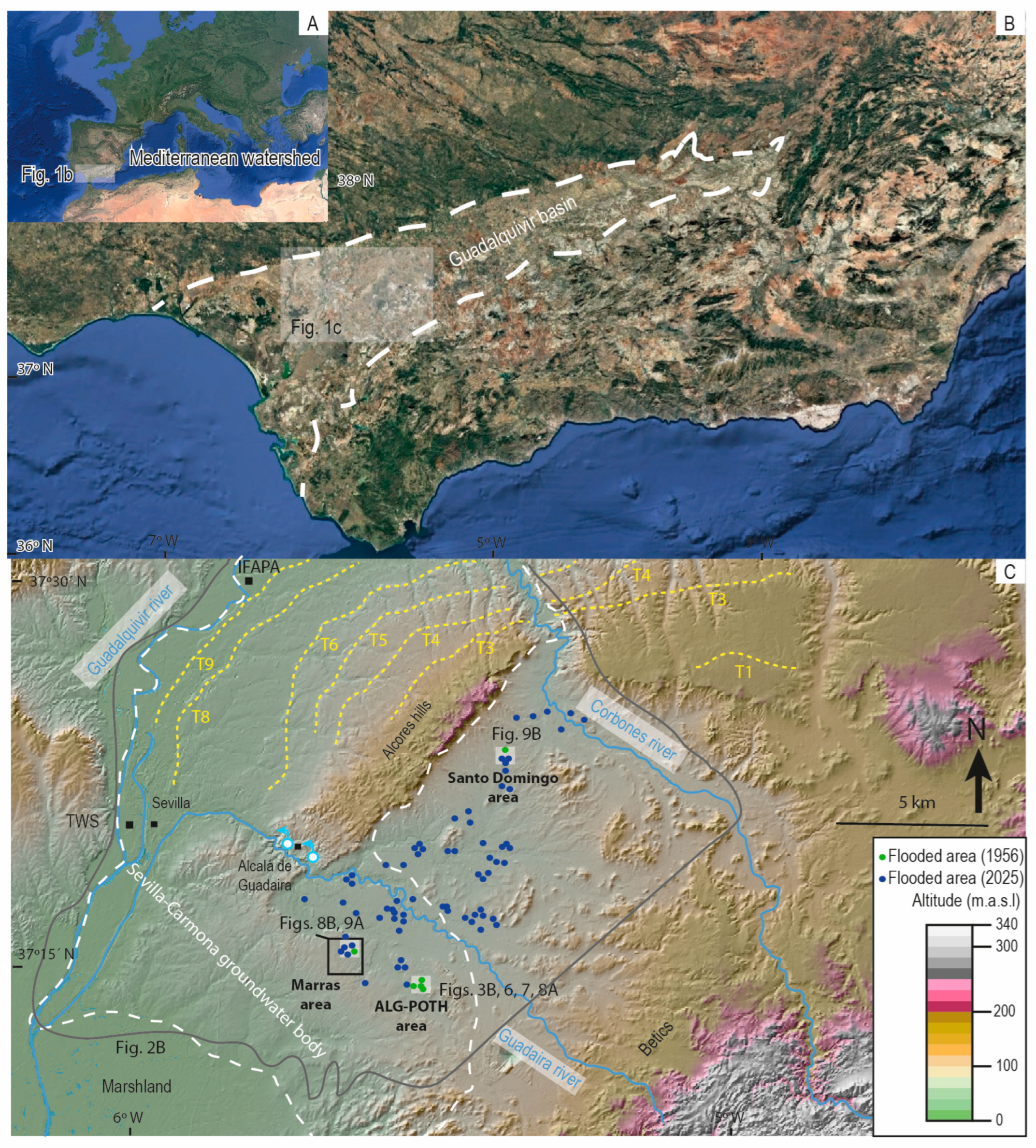
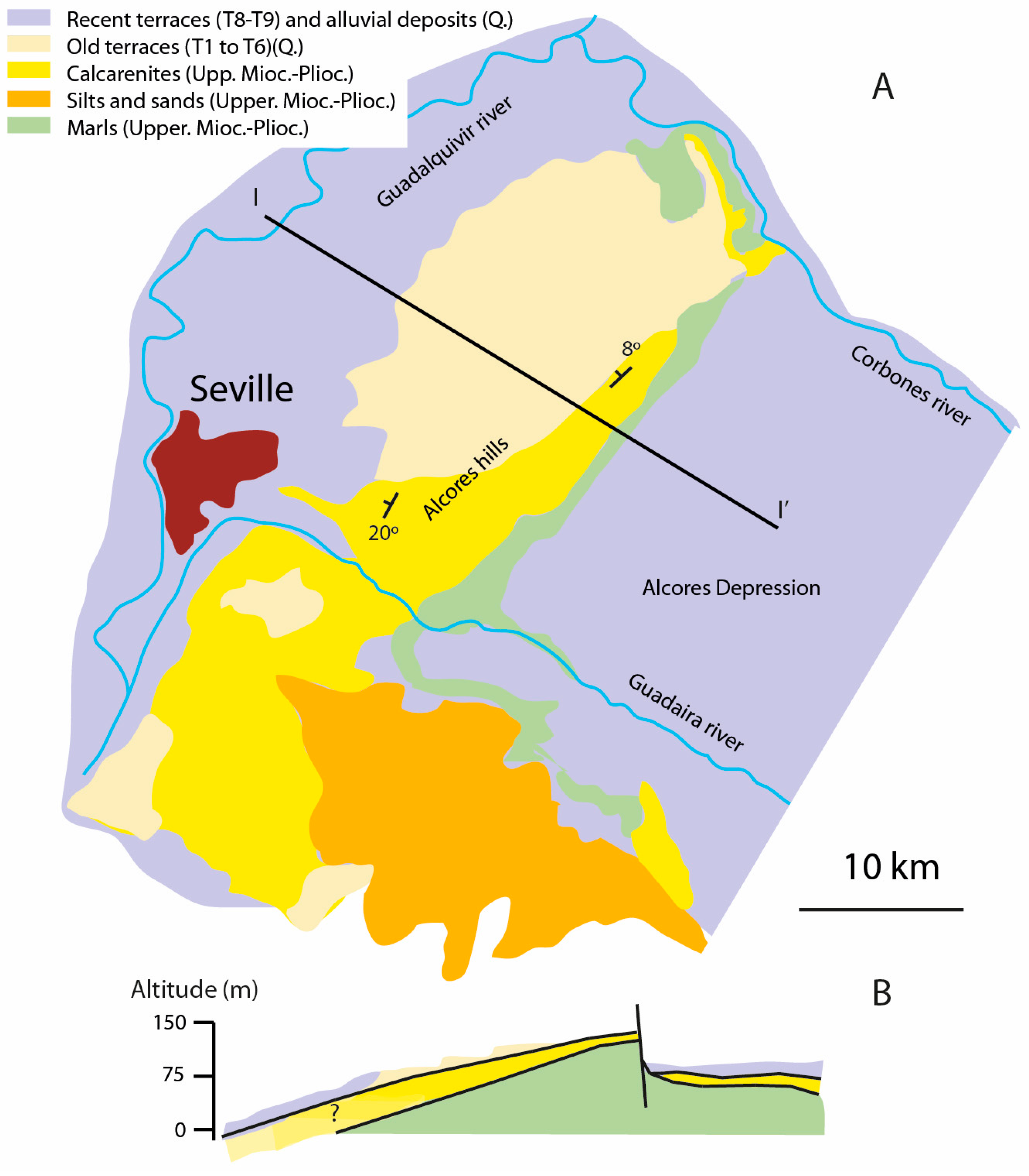

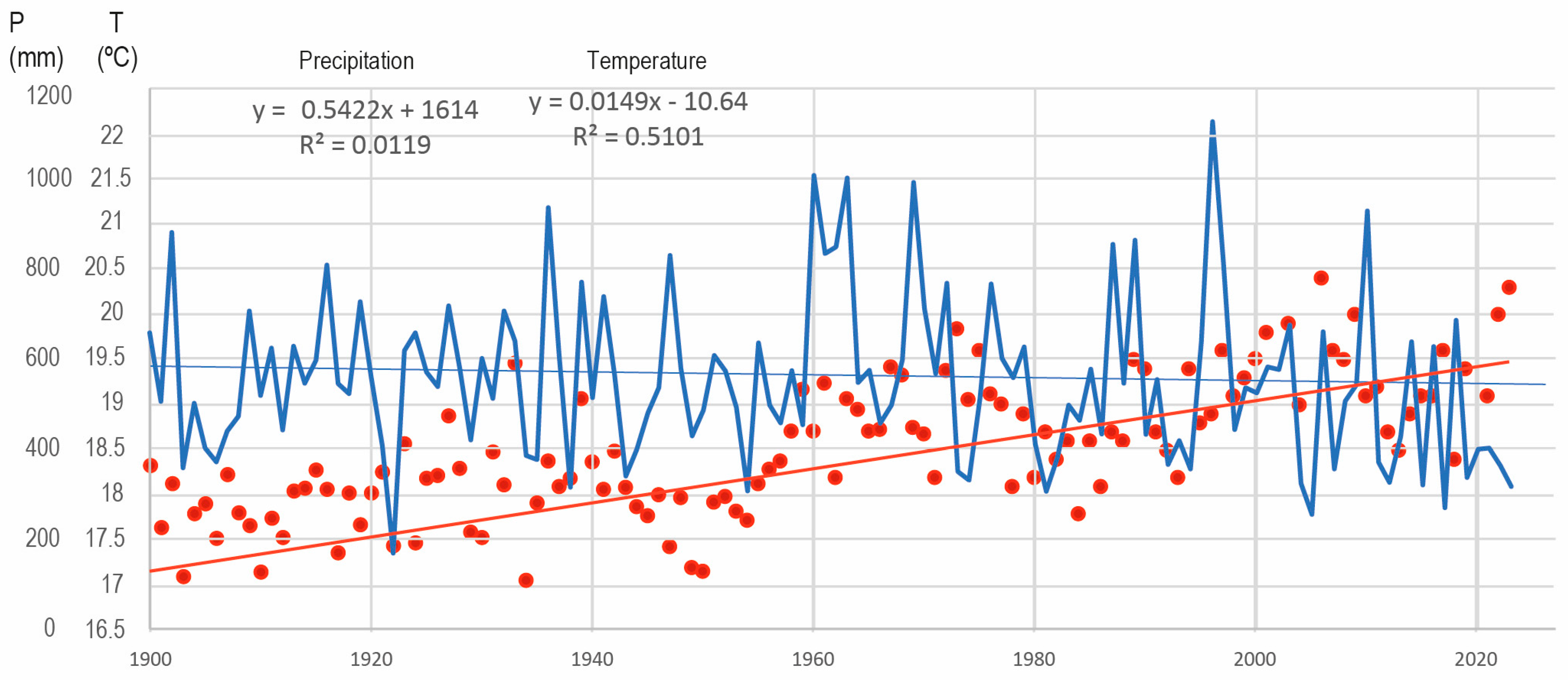
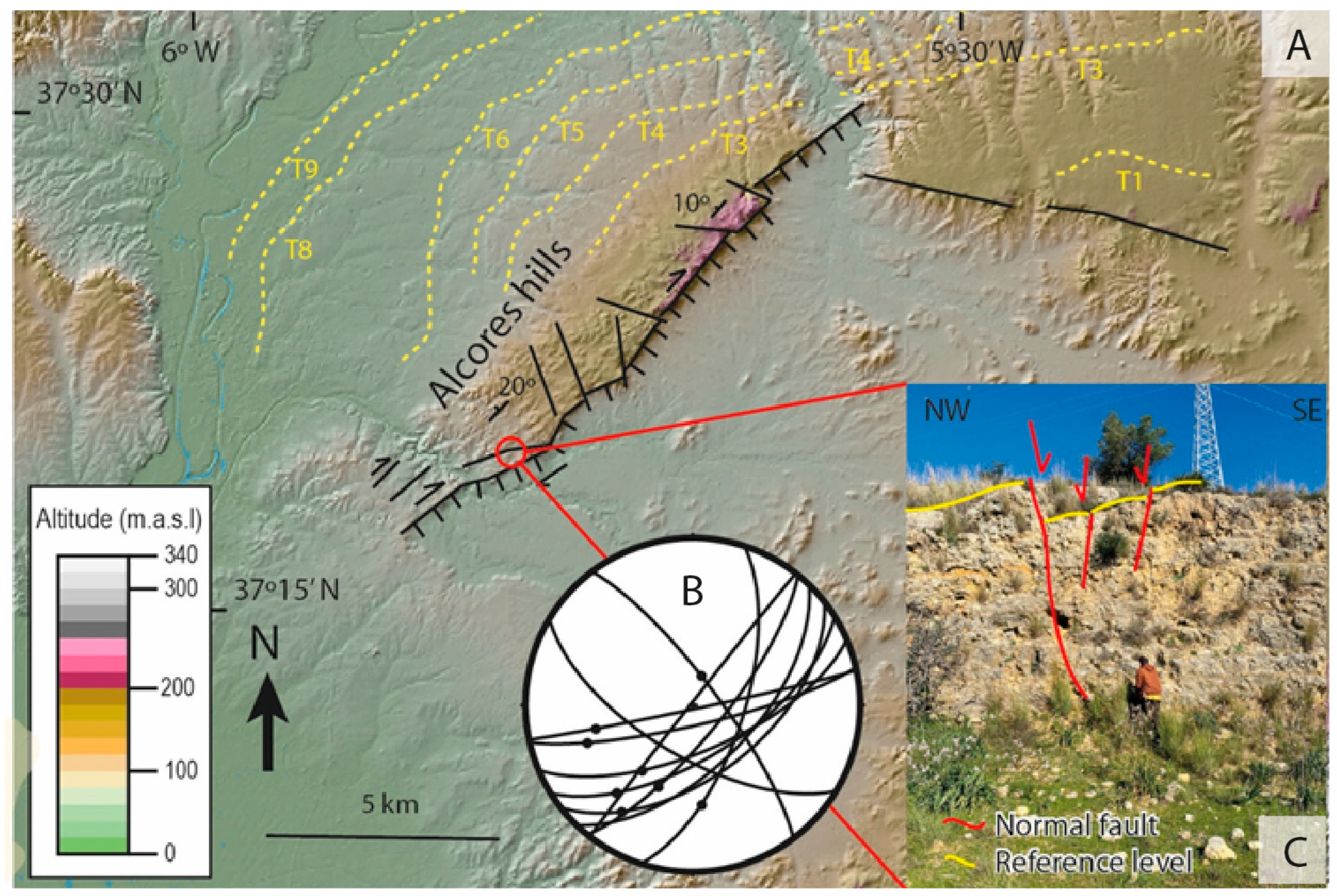
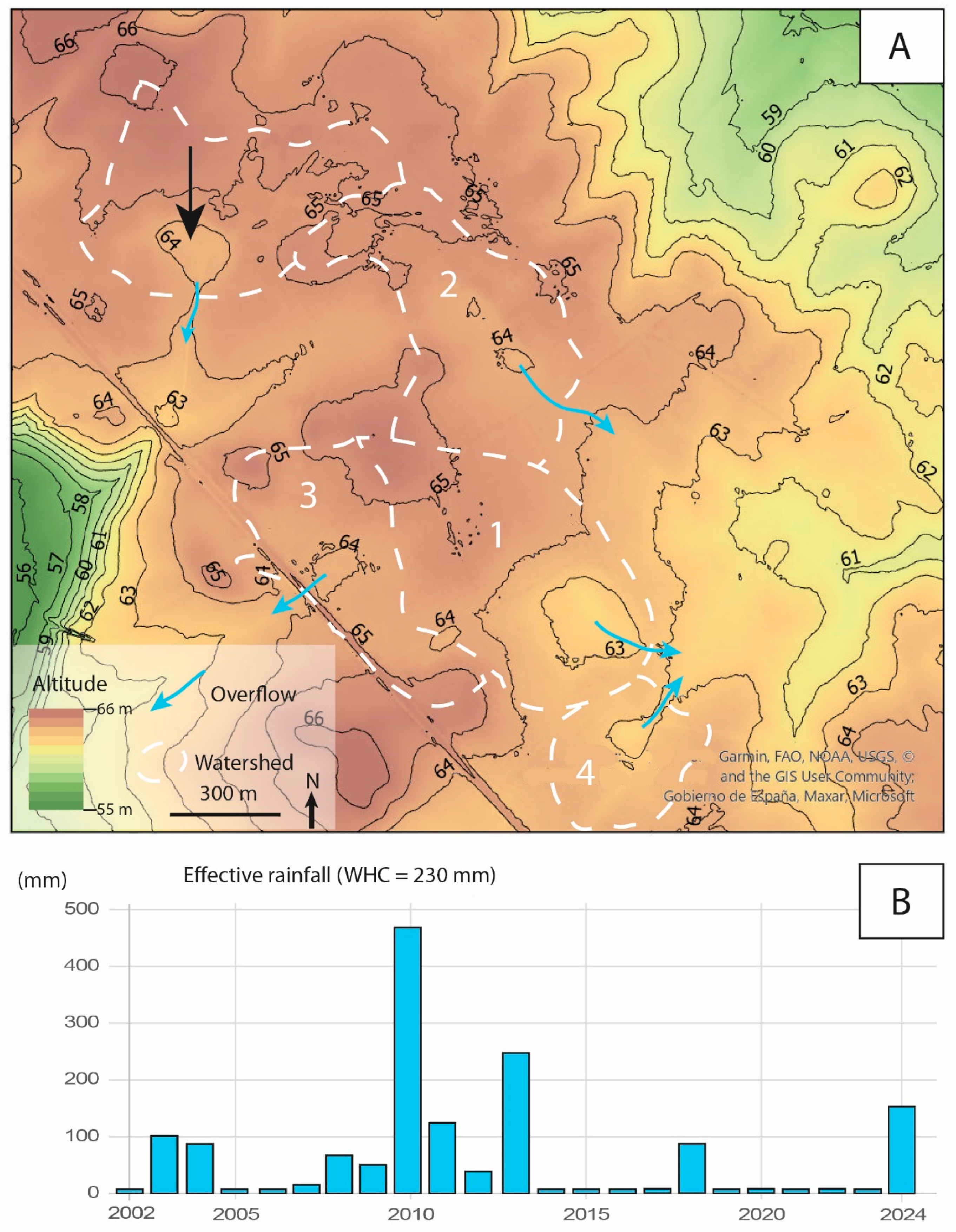
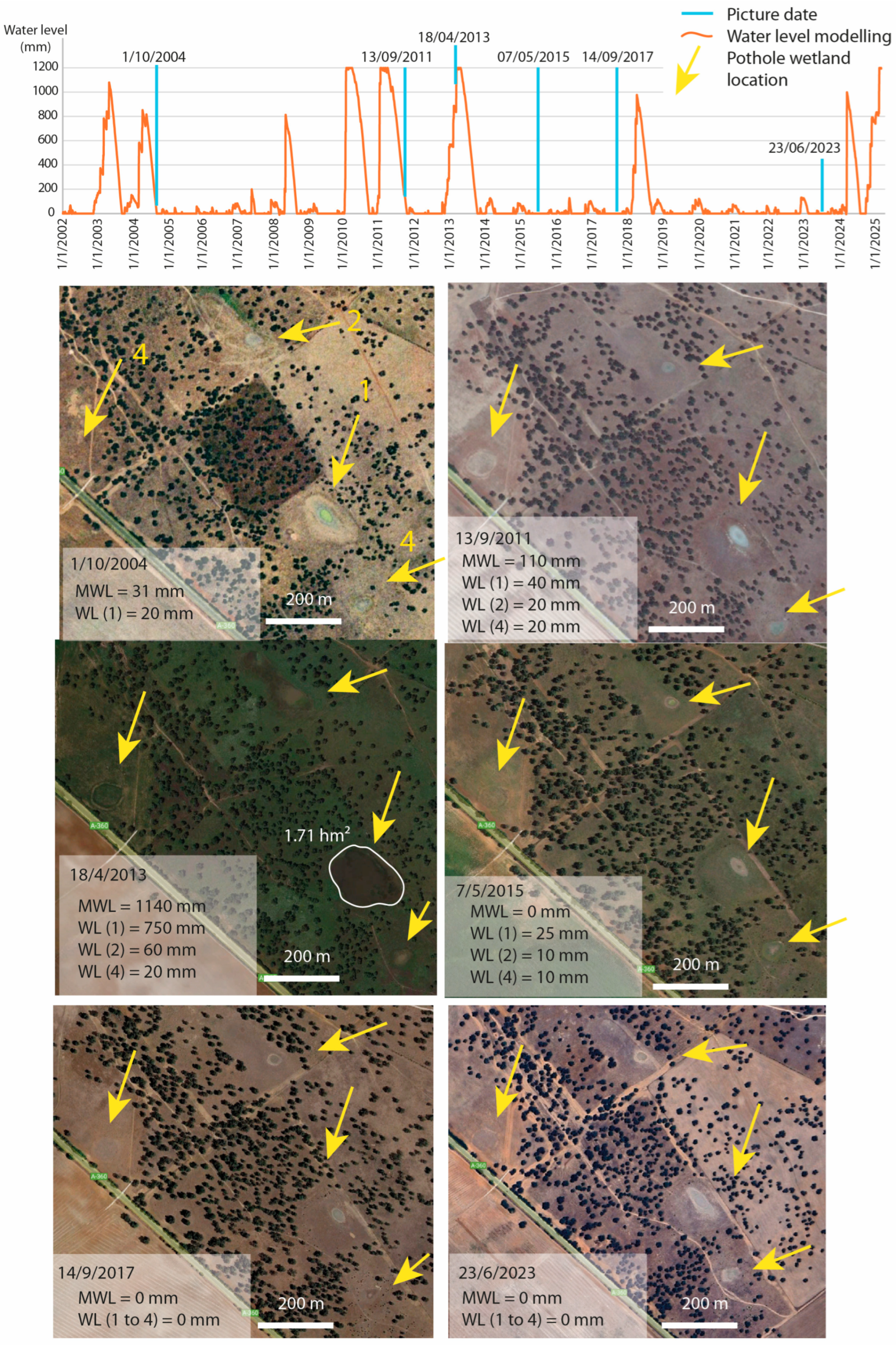
| January | February | March | April | May | June | July | August | September | October | November | December | Average | |
|---|---|---|---|---|---|---|---|---|---|---|---|---|---|
| Average temperature (°C) | 10 | 11.3 | 14 | 16.5 | 20.6 | 25.5 | 28 | 28.2 | 24.4 | 19.8 | 13.8 | 11.1 | 17.4 |
| Precipitation (mm) | 53 | 49 | 54 | 51 | 34 | 8 | 2 | 3 | 29 | 69 | 63 | 76 | 491 |
| Water Body | AFS (hm2) | W (hm2) | W/AFS | MFA (hm2) | Maximum Depth (m) | EC (µS/cm; Feb-2025) | HFI (m/yr) |
|---|---|---|---|---|---|---|---|
| 1 | 1.8 | 18.1 | 10.1 | 2 | 1.2 | 200 | 0.63 |
| 2 | 0.5 | 16.4 | 32.8 | 1.6 | 1 | 2.05 | |
| 3 | 0.1 | 8 | 80 | 0.5 | 0.4 | 160 | 5 |
| 4 | 0.1 | 5.6 | 56 | 0.5 | 0.5 | 3.5 |
Disclaimer/Publisher’s Note: The statements, opinions and data contained in all publications are solely those of the individual author(s) and contributor(s) and not of MDPI and/or the editor(s). MDPI and/or the editor(s) disclaim responsibility for any injury to people or property resulting from any ideas, methods, instructions or products referred to in the content. |
© 2025 by the authors. Licensee MDPI, Basel, Switzerland. This article is an open access article distributed under the terms and conditions of the Creative Commons Attribution (CC BY) license (https://creativecommons.org/licenses/by/4.0/).
Share and Cite
Jiménez-Bonilla, A.; Expósito, I.; Gázquez, F.; Yanes, J.L.; Rodríguez-Rodríguez, M. The Nucleation and Degradation of Pothole Wetlands by Human-Driven Activities and Climate During the Quaternary in a Semi-Arid Region (Southern Iberian Peninsula). Geographies 2025, 5, 27. https://doi.org/10.3390/geographies5030027
Jiménez-Bonilla A, Expósito I, Gázquez F, Yanes JL, Rodríguez-Rodríguez M. The Nucleation and Degradation of Pothole Wetlands by Human-Driven Activities and Climate During the Quaternary in a Semi-Arid Region (Southern Iberian Peninsula). Geographies. 2025; 5(3):27. https://doi.org/10.3390/geographies5030027
Chicago/Turabian StyleJiménez-Bonilla, A., I. Expósito, F. Gázquez, J. L. Yanes, and M. Rodríguez-Rodríguez. 2025. "The Nucleation and Degradation of Pothole Wetlands by Human-Driven Activities and Climate During the Quaternary in a Semi-Arid Region (Southern Iberian Peninsula)" Geographies 5, no. 3: 27. https://doi.org/10.3390/geographies5030027
APA StyleJiménez-Bonilla, A., Expósito, I., Gázquez, F., Yanes, J. L., & Rodríguez-Rodríguez, M. (2025). The Nucleation and Degradation of Pothole Wetlands by Human-Driven Activities and Climate During the Quaternary in a Semi-Arid Region (Southern Iberian Peninsula). Geographies, 5(3), 27. https://doi.org/10.3390/geographies5030027






